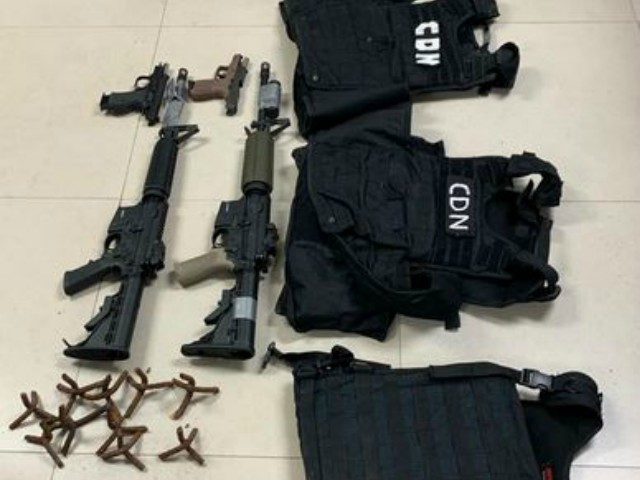Cartel violence at the Texas-Mexico border is at the point where people are dying on both sides. Despite a longstanding tradition of violence between cartels, events in the past few months are transforming the battlefield at the expense of all area residents—Mexican and American.
In July 2019, the Cartel del Noreste (CDN) faction of Los Zetas used armored convoys with mounted machine guns to invade the small community across the Rio Grande from Fronton, Texas. This was considered Gulf Cartel turf for decades. This one event should have been recognized by both Mexico and the U.S. as a significant indicator that Tamaulipas would be embroiled in yet another hot cartel war.
Days later, leaders of the local Gulf Cartel faction were executed, missing, or were caught by U.S. Border Patrol. At one point, law enforcement on both sides of the river began to realize a coup was underway and a broader war was on the horizon.
#Sicarios del #CarteldelGolfo ejecutan al cmte Gordo Sexy que tenia la plaza en #MiguelAleman #Tamaulipas alparecer y segun en un #Video que circula en grupos de whatsapp y quien se adjudica la ejecucion seria el cmte Pezon del mismo #CDG #MexicoRojo #ReynosaFollow #USA #EU #EUA pic.twitter.com/HtZr0MqNJn
— #MexicoRojo (@_MexicoRojo_) July 16, 2019
New levels of violence became clear on August 6. The first of many sustained gun battles between the Gulf and CDN would last hours immediately across from Roma, Texas. For three days, new battle lines were drawn without regard for civilians in the conflict zone. The worst of these battles took place between the two communities of Miguel Aleman and Los Guerra. After four days of consistently fighting, matters escalated to the point that U.S. Border Patrol agents took fire. A marine unit was hit with more than 50 rounds from multiple ambush positions on the Mexican side of the Rio Grande.
The CDN-driven violence continued, requiring Tamaulipas Governor Francisco Javier Garcia Cabeza De Vaca to send large numbers of state police into Nuevo Laredo to regain control of the area. In one incident, officers were viciously attacked at the Santa Teresa Hotel.
In a letter to Mexican President Andres Manuel Lopez Obrador (AMLO), the governor requested federal support to more quickly secure the region. AMLO later announced the Secretary of Public Safety and Defense Ministry would be tasked to help stem the tide of violence.
By September, the CDN’s terror campaign focused the state capitol and its main government buildings known as the Bicentennial Towers. Four gunmen assaulted the facility before being killed. This marked a pivotal moment for state leaders.
Even with September’s lessons in mind for Tamaulipas leadership, October and November held more skirmishes in the border cities of Miguel Aleman, Los Guerra, Ciudad Mier, Ciudad Victoria, the outskirts of Reynosa, and small communities around Nuevo Laredo. Many of these were between cartels and law enforcement. At this point, local officials and media lost the ability to accurately monitor the bloodshed.
These incidents left a wake of carnage upon citizens from both sides of the border. Victims continue to be taken hostage, robbed, and killed. The use of cartel roadblocks are so prevalent, the U.S. State Department’s most recent travel advisory warns against particular roadways near the border in Tamaulipas.
New Year’s Eve marked a close shave in confronting a wanted narco-terrorist. A dramatic shootout almost captured the leader of CDN, Hector Raul “El Tory” Luna Luna. El Tory was reportedly injured in a firefight but managed to escape. The following day, a large convoy of gunmen in armored vehicles with 50.cal belt-fed mounted machine guns attacked state police officers at the Villareal Hotel in Nuevo Laredo. Video emerged on social media of officers pinned down by gunfire. Videos began emerging on social media reportedly from Laredo, Texas, were battle noises could be heard.
Video sent in a few minutes ago from my cousin who live in Laredo, TX a few blocks from Nuevo Laredo, Tamaulipas, Mexico. Gunshots are to be coming from the Mexican region, no word on any spillover here. The entire video doesn’t fit but has 2 and a half minutes of gunfire. pic.twitter.com/bu3B3mZNQV
— Lisette Hernandez TV (@lisette_tv) January 2, 2020
U.S. consulate warns employees as gun battles rock Mexican border city https://t.co/AKjzzDemRD | #NuevoLaredo #Mexico #Texas pic.twitter.com/UZwZ9NM2hf
— DiepTLam (@DiepTLam) January 2, 2020
Webb County Sheriff Martin Cuellar asked citizens to not cross into Nuevo Laredo due to reports of high caliber rifles and explosives.
Later in January, a roadblock conducted by CDN in Nueva Ciudad Guerrero resulted in the killing of a 13-year-old U.S. citizen from Oklahoma who was reportedly shot several times. Three of his relatives, including a 10-year-old girl, also sustained wounds.
State and federal forces in Tamaulipas remain out of sync in combating cartel violence near Texas. Sources within the Mexican Marines told Breitbart Texas they are aware of and monitor the worsening bloodshed, but cannot get clearance to engage—despite being stationed roughly 20 miles away from most hot zones.
Without major adjustments to strategy and cooperation, citizens from both sides of the border will continue to increasingly cover those deficits with blood.
Jaeson Jones is a retired Captain from the Texas Department of Public Safety’s Intelligence and Counterterrorism Division and a Breitbart Texas contributor. While on duty, he managed daily operations for the Texas Rangers Border Security Operations Center.

COMMENTS
Please let us know if you're having issues with commenting.